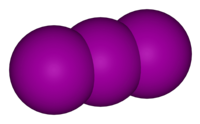
Photo from wikipedia
Solid-state reactions are influenced by the spatial arrangement of the reactants and the electrostatic environment of the lattice, which may enable lattice-directed chemical dynamics. Unlike the caging imposed by an… Click to show full abstract
Solid-state reactions are influenced by the spatial arrangement of the reactants and the electrostatic environment of the lattice, which may enable lattice-directed chemical dynamics. Unlike the caging imposed by an inert matrix, an active lattice participates in the reaction, however, little evidence of such lattice participation has been gathered on ultrafast timescales due to the irreversibility of solid-state chemical systems. Here, by lowering the temperature to 80 K, we have been able to study the dissociative photochemistry of the triiodide anion (I3-) in single-crystal tetra-n-butylammonium triiodide using broadband transient absorption spectroscopy. We identified the coherently formed tetraiodide radical anion (I4•-) as a reaction intermediate. Its delayed appearance after that of the primary photoproduct, diiodide radical I2•-, indicates that I4•- was formed via a secondary reaction between a dissociated iodine radical (I•) and an adjacent I3-. This chemistry occurs as a result of the intermolecular interaction determined by the crystalline arrangement and is in stark contrast with previous solution studies.
Journal Title: Nature chemistry
Year Published: 2017
Link to full text (if available)
Share on Social Media: Sign Up to like & get
recommendations!